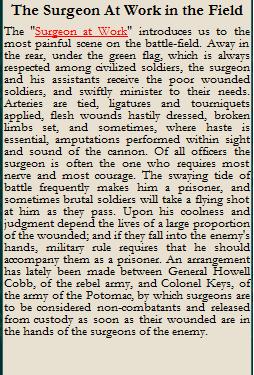War of Aggression Medicine
The state of medical knowledge at the time of the War of Aggression was extremely primitive. Doctors did not understand infection, and did little to prevent it. It was a time before antiseptics, and a time when there was no attempt to maintain sterility during surgery. No antibiotics were available, and minor wounds could easily become infected, and hence fatal. While the typical soldier was at very high risk of being shot and killed in combat, he faced an even greater risk of dying from disease.
Twice as many men died of disease than of gunshot wounds in the Civil War. Dysentery, measles, small pox, pneumonia, and malaria were the soldier’s greatest enemy. The overall poor hygiene in camp, the lack of adequate sanitation facilities, the cold and lack of shelter and suitable clothing, the poor quality of food and water, and the crowded condition of the camps made the typical camp a literal breeding ground for disease. Conditions, and resulting disease, were even worse for Civil War prisoners, who were held in the most miserable of conditions.
In order to try and curb these appalling conditions in camp, and the resulting rampant disease, the Sanitary Commission was formed. The Sanitary Commission tried to educate the army on proper sanitation techniques to help stem the spread of disease. The sanitary commission report issued in 1861 was widely disseminated, and included many guidelines to improve sanitation and reduce disease.
While soldiers were at risk of disease, they also faced great peril in battle. The “Civil War” was a very bloody affair. More men were killed in the “Civil War” than in all previous American Wars Combined! More men died at the Battle of Antietam than any other day in American History. The casualties at Antietam were twice the casualties suffered at D-Day. Part of the reason for these horrific casualty statistics is that the “Civil War” was the first American War in which Rifled barrels were extensively used. The rifled barrel significantly increased the range at which you could accurately hit a target. Despite this fact, the armies (the Union Army in particular) continued to use Napoleonic battle tactics. These tactics would send large forces of infantry against entrenched opponents. When an entrenched opponent was armed with smoothbore muskets, these Napoleonic tactics could work. The relative inaccuracy of the smoothbore muskets gave the advancing infantry a fair shot at actually reaching the enemies’ trenches, and then engaging in hand-to-hand combat. The pinpoint accuracy of the new rifled muskets, however, would allow the entrenched combatants to begin to thin the ranks of the advancing infantry at a very great range, and effectively decimate them before they could reach the entrenchments. The failure of the commanders to realize this fact, combined with similar advances in artillery, led to untold casualties and carnage in the war.
Amputation
The huge carnage that resulted from these frontal attacks, combined with a relatively few number of poorly equipped surgeons led to fairly dismal prospects for any soldier unlucky enough to be shot or otherwise injured in battle. Those with serious injuries in the torso would simply die. For those who were shot in an extremity, the options were few, in fact, really one: amputation. There is an interesting account of Battlefield medicine in the July 12, 1862 edition of Harper’s Weekly, which we present an excerpt below:

During major engagements the flood of wounded became simply overwhelming. The surgeon could afford to spend precious few minutes with each of the injured. This led to amputation being the treatment of choice for injuries to an appendage. Chloroform was used during the “Civil War”, when it was available. Use of Chloroform as an anesthetic greatly reduced the torture and trauma of the procedure. The Chloroform was applied to a cloth and held over the soldier’s nose and mouth until the man was unconscious.
Due to the enormous number of wounded, the “Civil War” Surgeons became proficient at performing amputations. In many cases the amputation would be performed in 10 minutes. Surgeons, along with their assistants, would work round the clock, ending up with stacks of amputated limbs up to five feet high. The number of wounded needing attention, and the relative lack of water meant that there was no attempt to wash hands or instruments between procedures. This lack of hygiene and sterility did create a large chance of infection. However, it has been estimated that as many as 75% of the amputees did recover.
The Practice of Surgery:
Amputation
Many “Civil War” surgeons would have learned the art of amputation from the book “The Practice of Surgery”, by Samuel Cooper, with Notes by Dr. Alexander H. Stephens. I have a copy of this book used by an actual “Civil War” Surgeon, Colonel Dr. Peter C. Woods of the Confederate States Army. The book is filled with fascinating details of the state of “Medicine” at the time of the “Civil War”. It is somewhat frightening to read the relative immaturity of the medical profession at this time.
![Reblog this post [with Zemanta]](https://i0.wp.com/img.zemanta.com/reblog_e.png)















